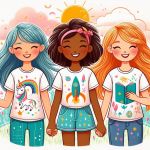Essay on the History of Children's Clothing in EuropeIntroduction The history of children's clothing in Europe is deeply intertwined with social, cultural, and economic developments throughout history. What children wore has changed dramatically over the centuries, reflecting shifts in attitudes towards childhood, class distinctions, and fashion trends. From the practical and simple garments of the Middle Ages to the elaborate and symbolic outfits of the modern era, the evolution of children's clothing provides valuable insight into the changing views of children in society. This essay will trace the development of children's clothing in Europe from ancient times through the modern era. Ancient Times and the Middle AgesIn ancient Europe, children's clothing was simple and functional, closely resembling that of adults. In ancient Greece and Rome, children wore tunics, which were practical garments designed for everyday use. These garments were typically made from linen or wool and were worn by both children and adults. There was little differentiation between children's and adults' clothing, as the concept of childhood as a separate life stage had not yet developed. During the Middle Ages, children's clothing followed a similar pattern, with the primary distinction being made based on social class. Wealthier children wore more elaborate and decorative garments, often made from fine fabrics such as silk or velvet. These clothes were designed to display the family’s wealth and status. For children from lower classes, clothing was much simpler and made from rougher materials such as wool or linen. The idea of childhood as a distinct phase of life, with its own specific needs and attire, was still in its infancy, and children often wore miniature versions of adult clothing. The Renaissance and Baroque Period: Emergence of Distinct Children's Styles With the Renaissance came a shift in the perception of childhood, and this was reflected in the development of children's clothing. The idea of childhood as a special, protected stage of life began to take root, and clothing began to reflect this distinction. Wealthy children were increasingly dressed in garments that were specifically designed for them, marking the emergence of a separate category of children’s fashion. In the 17th century, during the Baroque period, children’s clothing became more elaborate. Boys, for example, often wore knee-length pants paired with jackets or doublets, while girls wore dresses with voluminous skirts and elaborate decorations. The idea of innocence and purity was reinforced by clothing choices, with young children often dressed in highly decorative outfits that mirrored the adult fashion of the time. The "children’s coat," a formal and richly adorned garment, became symbolic of social status, reflecting the increasing importance of children's appearances in elite society. The 18th Century: The Era of “Individual Fashion” for Children The 18th century marked a significant shift in the history of children's clothing in Europe, as the concept of childhood continued to evolve. During this time, the fashion industry began to cater specifically to children. Wealthy families increasingly desired clothing that would distinguish children from adults, and children's attire became more individualized. Boys and girls began to be dressed in distinctly different styles. Boys were often dressed in short jackets and breeches, while girls wore dresses with wide skirts and tight bodices. The concept of dressing children in miniature versions of adult clothing remained popular, but the garments were tailored to reflect the delicate and innocent nature of childhood. It was during this period that the tradition of “dressing up” young boys in dresses or "locken" (a style of dress that included long locks of hair and ribbons) emerged, symbolizing innocence and purity until they reached a certain age. The 19th Century: Industrial Revolution and the Democratization of Children's Clothing The Industrial Revolution in the 19th century brought profound changes to the production of textiles and clothing in Europe. The advent of mass production and the mechanization of textile manufacturing made clothing more affordable and accessible to a broader range of people, including children. The new technology allowed for an increase in the variety of fabrics and styles, democratizing children's clothing and making it available to all classes. During this time, there was a more pronounced differentiation between boys' and girls' clothing. Boys began to wear trousers and jackets, reflecting a shift toward more practical and comfortable clothing for children. Girls, on the other hand, continued to wear dresses, although they became simpler and more functional. The clothing of children in the 19th century was still influenced by adult fashion, but there was a growing recognition of the need for practicality and ease of movement, especially for working-class children. The 19th century also saw the introduction of clothing specifically designed for children’s play and leisure activities, marking the beginning of the modern concept of casual children's clothing. As social expectations for children evolved, so did their clothing, which was increasingly seen as a reflection of a child's growing individuality and status. The 20th Century: Modernity and Mass Society The 20th century witnessed significant transformations in the fashion world, and children's clothing evolved alongside broader social changes. With the rise of mass production, children's clothing became more affordable, and brands and designers began to target this emerging market. The early part of the 20th century saw a shift toward more practical, comfortable clothing for children. The influence of the First World War and the Great Depression led to simpler, more utilitarian styles, as families had fewer resources to spend on elaborate clothing. In the 1920s and 1930s, children's fashion began to shift toward greater comfort and freedom of movement, with more emphasis placed on functional and less formal garments. Boys started wearing suits and trousers in everyday settings, and girls began wearing dresses with less rigid structures. This period also saw the rise of uniforms for children in schools, reinforcing the idea of conformity and social class distinctions. The post-World War II era saw the emergence of vibrant, playful designs for children's clothing, influenced by the growing consumer culture of the time. In the 1960s, as youth culture began to shape fashion, children's clothing became more varied and expressive. Brands like Disney and other media franchises began to cater to children’s tastes, while gender distinctions in clothing also became more pronounced. The fashion industry increasingly marketed specific styles for boys and girls, which reflected changing societal expectations and gender roles. In the late 20th and early 21st centuries, children's clothing became even more diversified. The rise of fast fashion and the influence of social media have contributed to a global market for children's clothes that reflect both individual preferences and trends. Brands now offer a wide range of options, from gender-neutral clothing to items that reflect the latest fashion trends, allowing children more opportunities to express their personalities through their clothes. Conclusion The history of children's clothing in Europe is a story of evolution, marked by changing societal norms, economic progress, and technological innovations. From the simple and practical garments of ancient times to the distinct, often decorative outfits of the Renaissance and Baroque periods, and finally to the comfortable, expressive styles of the modern era, children's clothing has always reflected broader cultural shifts. Today, the diversity in children's clothing represents not only practical considerations but also individual expression, with children now having more freedom than ever before to choose and wear clothes that reflect their identities. The evolution of children's clothing is not just about fashion; it mirrors changing attitudes towards childhood, innocence, and personal autonomy.  |

































